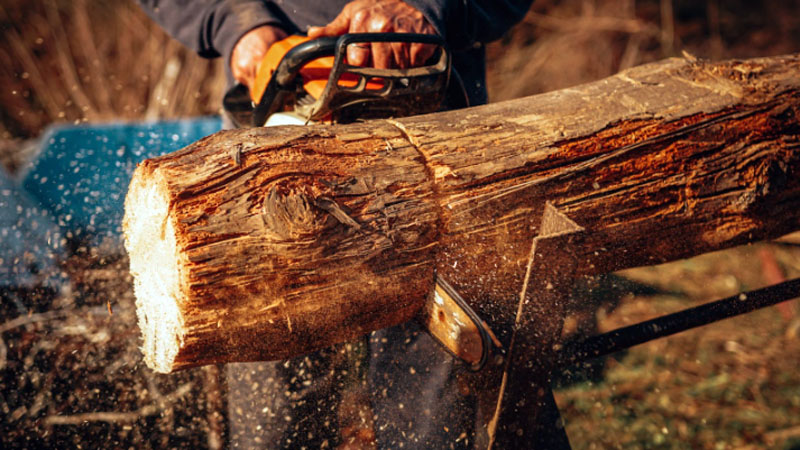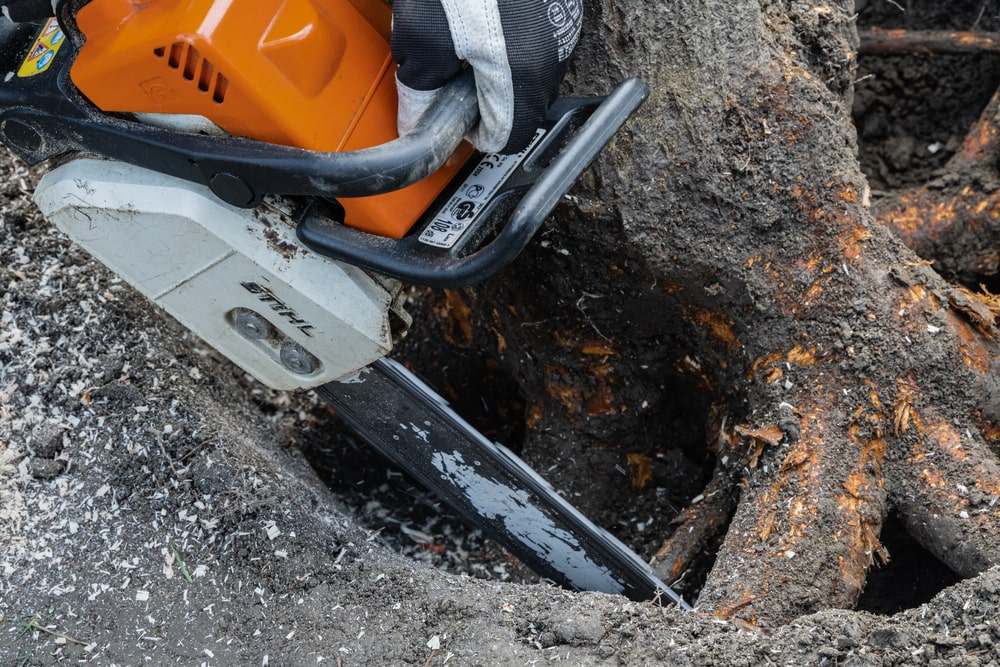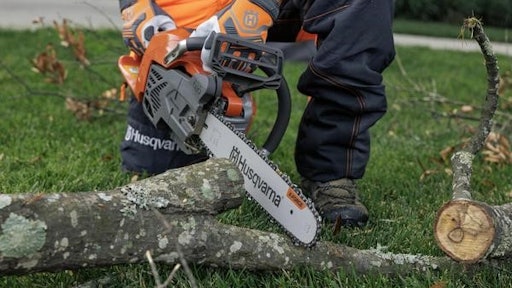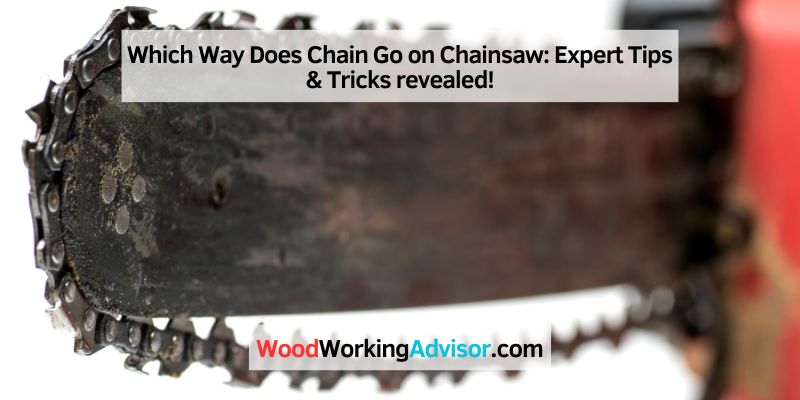The chain on a chainsaw rotates clockwise around the guide bar. A chainsaw chain goes in a clockwise direction around the guide bar.
When using a chainsaw, it is crucial to know the correct orientation of the chain to ensure safe and efficient operation.

Credit: www.chainsawspares.com.au
The Basics Of Chainsaw Chains
A chainsaw chain is an essential component of a chainsaw that determines its cutting performance. It is a loop of sharp teeth that rotates around the chainsaw’s guide bar, enabling it to cut through wood with precision and efficiency. Understanding the basics of chainsaw chains is crucial for any chainsaw user.
Chain Direction
Properly installing the chainsaw chain is of utmost importance for safe and effective operation. The chain is designed to rotate in a specific direction, which can be identified by arrow-shaped indicators on the chain. This arrow indicates the correct direction in which the chain should be installed on the chainsaw guide bar. It is typically oriented towards the front of the chainsaw, ensuring proper cutting performance.
Importance Of Chain Direction
The direction in which the chainsaw chain is installed plays a crucial role in its overall performance. Correct installation ensures that the chain teeth engage the wood properly, resulting in efficient cutting. Moreover, the chain’s design is optimized for cutting in a particular direction, allowing it to clear wood debris effectively without jamming or getting stuck.
Installing the chainsaw chain in the wrong direction can lead to increased kickback, which is a sudden and dangerous upward motion of the chainsaw. Kickback can occur when the chain teeth contact the wood incorrectly, causing the chain to forcefully kick back towards the user. By following the correct chain direction, you can minimize the risk of kickback and ensure a safer chainsaw operation.
Installing the chainsaw chain in the correct direction also helps in extending its lifespan. With proper alignment, the chain experiences less strain and wear, allowing it to maintain its cutting efficiency for a longer period. This not only saves you money on chain replacements but also ensures that your chainsaw performs optimally throughout its lifespan.
To ensure safe and effective chainsaw operation, carefully follow the manufacturer’s instructions and ensure that the chainsaw chain is installed correctly in the indicated direction. Periodically inspect the chain for proper tension, sharpness, and alignment to maintain its optimum performance.

Credit: www.groundsguys.com
Correct Installation Of Chainsaw Chain
Installing the chainsaw chain correctly is crucial to ensure smooth operation and optimal performance. One important aspect of correct installation is to know which way the chain goes on the chainsaw. In this section, we will discuss the alignment with the bar and tensioning the chain for proper installation.
Alignment With The Bar
Proper alignment of the chainsaw chain with the bar is essential for efficient cutting and reduced wear. To ensure correct alignment:
- Place the chainsaw on a flat surface and engage the chain brake.
- Inspect the bar for any signs of damage or wear. Replace if necessary.
- Locate the drive teeth on the bar and position the saw chain so that the cutting teeth face forward.
- Gently position the chain around the bar, ensuring it sits snugly in the guide groove.
- Double-check the alignment by rotating the chain manually. It should move freely without binding.
Tensioning The Chain
Proper tensioning of the chainsaw chain is vital for safe and efficient operation. Follow these steps to ensure optimal tension:
- Before tensioning, ensure the chainsaw is turned off and the chain brake is engaged.
- Find the tensioning adjustment mechanism, usually located on the side of the chainsaw.
- Use the appropriate tool, such as a screwdriver or tensioning tool, to adjust the tension.
- Tighten the chain until it fits snugly against the bar, but still allows easy manual rotation.
- Check the tension by pulling the chain away from the bar. It should have a slight amount of slack.
Remember to regularly check and adjust the chain tension as it may loosen during use. A properly tensioned chain ensures optimal cutting performance and reduces the risk of accidents.
Common Mistakes With Chainsaw Chains
Chainsaw maintenance is crucial for optimal performance and safety but many users make mistakes when it comes to handling chainsaw chains. By avoiding some common errors, you can ensure that your chainsaw operates smoothly and effectively.
Reverse Installation
Installing the chainsaw chain in the wrong direction is a common mistake. It’s essential to ensure that the teeth of the chainsaw chain are facing toward the front of the chainsaw. Reversing the installation can lead to inefficient cutting and potential safety hazards.
Incorrect Tensioning
Another issue that arises frequently is improper tensioning of the chainsaw chain. Over-tightening or under-tightening the chain can lead to decreased cutting efficiency and can even cause damage to the chainsaw itself. It’s crucial to follow the manufacturer’s guidelines to achieve the correct tension for the chain.
Effect Of Chain Direction On Performance
The direction of the chain on a chainsaw significantly affects its performance. Incorrect chain direction can lead to kickback and reduced cutting efficiency. It is essential to install the chain in the correct direction to ensure safe and effective operation.
Proper chain direction plays a crucial role in determining the cutting efficiency and safety of a chainsaw. Installing the chain correctly ensures that the saw operates smoothly, reduces the risk of accidents, and improves overall performance. Understanding the effect of chain direction on performance is essential for both experienced operators and beginners.
Cutting Efficiency
Installing the chain in the correct direction significantly impacts the cutting efficiency of a chainsaw. The orientation of the cutting teeth on the chain determines the way wood fibers are cut. When the chain is installed properly, with the cutting teeth facing toward the front of the chainsaw, it results in cleaner and more efficient cuts.
With the proper chain direction, the cutting teeth engage with the wood and effectively slice through it. This allows the chainsaw to remove material smoothly, reducing the effort needed to make cuts and maximizing the performance of the saw. Furthermore, having the chain installed correctly minimizes the chances of the saw getting stuck or binding during operation.
A chainsaw with an incorrectly installed chain may not cut effectively, resulting in rough or jagged cuts. The cutting teeth may struggle to engage with the wood, making it difficult to progress through the material. This inefficiency can cause strain on the chainsaw’s engine, reduce cutting speed, and negatively impact the overall effectiveness of the tool.
Safety Considerations
Choosing the appropriate chain direction also has direct implications for safety. Installing the chain in the wrong direction can increase the likelihood of accidents and potential injury.
- When the chain is facing the wrong way, there is an increased risk of kickback. Kickback occurs when the chain’s upper surface makes accidental contact with the wood, causing a sudden and forceful upward motion of the chainsaw. This sudden movement can catch operators off guard, leading to loss of control and possible injuries.
- In addition to kickback, an improperly installed chain may result in more frequent chain derailments. This can happen when the chain comes off the guide bar, posing a safety hazard to the operator and potentially causing damage to the chainsaw.
By ensuring the chain is properly positioned, operators can reduce the risk of accidents and promote a safer working environment. Knowing the correct chain direction and following the manufacturer’s guidelines are essential steps in maintaining safety while operating a chainsaw.
Maintenance And Replacement
The direction of the chain on a chainsaw is crucial for proper maintenance and replacement. Knowing which way the chain goes ensures optimal performance and safety during operation.
Regular maintenance and proper replacement of the chainsaw chain are essential for ensuring its optimal performance and longevity. Neglecting this aspect can lead to inefficient cutting, increased wear and tear, and even potential safety hazards. In this section, we will delve into two crucial aspects of chainsaw maintenance and replacement: chain wear and replacement, as well as lubrication and cleaning.
Chain Wear and Replacement
The chain of a chainsaw experiences wear and tear with every use, gradually reducing its cutting efficiency and posing a risk to both the operator and the equipment. It is important to know when the chain needs replacement to maintain peak performance.
To determine if your chainsaw chain is worn, carefully inspect it for the following signs:
1. Blunt or Rounded Cutting Teeth: Blunt or rounded cutting teeth are a clear indication that your chain has lost its sharpness. Dull chains result in slower cutting speeds, increased effort required, and a higher likelihood of kickback. Kickback is a sudden upward movement of the chainsaw, which can be dangerous.
2. Excessive Vibration: If your chainsaw starts vibrating excessively during operation, it could be due to a worn-out chain. As the chain wears down, it loses its balance, leading to increased vibration levels. Not only does this affect cutting precision, but it can also cause discomfort and fatigue to the operator.
3. Uneven Cutting: A worn-out chain may cause the chainsaw to cut unevenly or pull to one side. This can result in angled or crooked cuts, impacting the quality of your work. It is crucial to address this issue promptly to maintain accuracy and avoid potential accidents.
When you notice any of these signs, it is time to replace your chainsaw chain. Regularly inspecting and replacing the chain when necessary will ensure smooth cutting performance and reduce the risk of accidents.
Lubrication and Cleaning
Proper lubrication and cleaning of the chainsaw chain are integral to its durability and smooth operation. This maintenance practice not only extends the lifespan of the chain but also helps maintain cutting efficiency.
Here are some important steps to follow for effective lubrication and cleaning:
1. Select the Right Chain Oil: Choose a high-quality chain oil designed specifically for chainsaws. Chain oil is specially formulated to reduce friction, prevent rust and corrosion, and provide lubrication to the chain. Using the correct chain oil will optimize the overall performance of your chainsaw.
2. Check the Oil Levels: Before each use, check the oil levels in the chainsaw reservoir. A well-lubricated chain ensures smoother operation and reduces the chances of overheating and premature wear. Ensure there is an adequate supply of oil and refill if necessary.
3. Regularly Clean the Chain: After prolonged use, chainsaw chains can accumulate debris, such as wood chips, sap, and dirt. Regularly cleaning the chain not only improves its performance but also prevents debris from clogging the bar and causing damage. Use a brush or specialized chain cleaner to remove any build-up on the chain’s surface and between the cutting teeth.
4. Inspect the Guide Bar: Along with the chain, it is important to inspect and clean the guide bar. Remove the guide bar and check for any buildup or residue. Clean it thoroughly and ensure the oil delivery ports are not clogged.
By incorporating these maintenance practices into your chainsaw care routine, you can optimize the lifespan of your chain, promote smoother cutting, and ensure safe and effective operation.
Remember, a well-maintained chainsaw chain not only enhances performance but also contributes to a longer tool lifespan – resulting in cost savings in the long run.

Credit: www.greenindustrypros.com
Frequently Asked Questions On Which Way Does Chain Go On Chainsaw
What Direction Does Chain Go On Chainsaw?
The chain on a chainsaw should go in the direction stated by the manufacturer. Follow their guidelines for optimal performance and safety.
Can A Chainsaw Chain Be Put On The Wrong Way?
Yes, a chainsaw chain can be put on the wrong way, affecting its performance and safety.
Which Way Does A Chainsaw File Go?
The chainsaw file should be inserted with the cutting edges facing toward the chainsaw blade.
Does It Matter If Chainsaw Bar Is Upside Down?
No, it does not matter if the chainsaw bar is upside down.
Conclusion
Ensuring the correct installation of a chainsaw chain contributes to its overall performance. By understanding the correct direction of the chain, you can prevent accidents and improve cutting efficiency. Remember to consult your chainsaw’s manual for specific instructions and seek professional assistance if needed.
Proper maintenance and care ensure the chainsaw operates safely and effectively.


